
Jules Charles Toussaint Védrines (1881-1919)
The People of Limoux, France, couldn't believe it. In March 1912, just one week before they were going to elect a deputy, a new candidate suddenly dropped from the sky: an aviator named Jules Védrines. A native of Saint-Denis who received his pilot's license in 1910, Védrines had won the Paris-Madrid air race in 1911 before setting a speed record by being the first to surpass 62 miles per hour. He had decided to run for deputy so that the world of aviation would have a voice in Parliament.
Paris to Madrid Air Race 1911 was marked by numerous air races, which were organised by newspapers. They were generally long-distance, and as much a test of pilot stamina and navigational skills as of the airworthiness of their aeroplanes. Great numbers of competitors as well as spectators were attracted, and some truly impressive performances were witnessed. French pilots, being the most experienced in Europe, tended to take most of the honours.
Among those watching the start at Issy-les- Moulineux on 21 May 1911 was the French Minister of War, M.Berteaux. He stepped in front of an aircraft and was killed. The rest of the competition was put off to the following day. The only pilot to succeed in completing the course, which included a flight over or around the Pyrennes, was ex-mechanic Jules Védrines in his Morane-Borel monoplane.
Jules Védrines Jules Védrines devient célèbre à 30 ans en remportant la course aérienne Paris-Madrid en 1911. En 1914, il rejoint l'aviation militaire. Sa verve moqueuse et expressive tranche sur les manières quelque peu composées de ses camarades. Son avion porte non des armes aristocratiques mais une vache, hommage à ses origines limousines. Travaillant souvent avec les services spéciaux, Védrines devient bientôt l'as des missions spéciales, infiltrant espions et saboteurs derrière les lignes allemandes. Il va toujours récupérer ses passagers quelques jours plus tard, au risque d'être capturé et fusiller comme franc-tireur. "La Vache" ira jusqu'à se poser sous le feu de l'ennemi pour récupérer un agent en difficulté, Malgré tous ses succès, "La Vache" garde toujours la tête froide et accepte en 1915 de former un jeune pilote Georges Guynemer. En 1919, démobilisé, Védrines se lance dans la politique tout en poursuivant ses exploits de pilote. Cette année, il sepose sur le toit des galeries Lafayette à Paris mais se tue dans une course aérienne.
Jules Védrines Jules Charles Toussaint Védrines, est nè le 21 dècembre 1881 La Plaine-St Denis, prës de Paris (93) ouvrier, puis metteur au point aux Usines Gnome (Moteur), avant de devenir mècanicien du pilote-acteur Anglais, Robert Loraine,ce qui lui donna son tour, le dèsir de devenir aviateur, il passe son brevet de pilote le 7 dècembre 1910 Pau, (tirè de la Bibliothëque de l'Aviation Populaire, Jacques Mortane aux Editions Baudiniere), devient un As de l'aviation. Védrines a ètè le1er pilote dèpasser les 100 km heure, le seul atterrir sur le toit des Galeries Lafayette Paris le 19 Janvier 1919, il a gagnè la coupe Gordon-Bennet en Amèrique, en battant le record de vitesse 167,8 km/h, le 9 dècembre 1912, son avion qu'il a appelè " La Vache" s°ree;rement en rèfèrence au fait qu'il devait souvent "brouter l'herbe",et "les Marguerites,"ce pourquoi ces pionniers de l'aviation ont ètè nommès "les Faucheurs de Marguerites" Si Rolland Garros ètait "l'aviateur èlègant ", Védrines ètait surnommè "le gavroche sublime, "le Parigot gouailleur ". Il s'est tuè 38 ans, le 21 Avril 1919, avec son mècanicien Guillain, St Rambert d'Albon, (Drùme, ) lors d'un raid Paris-Rome, bord d'un bimoteur Caudron C-23 rempli de 1600 litres d'essence. Le 26 avril 1919, le peuple de Paris conduisait les corps, de Védrines et Guillain, au cimetiëre de Pantin.
Those Magnificent Turks in Their Flying Machines The re-enactment of the doomed Istanbul-Cairo expedition of 1914 has kindled renewed interest in early aviation. Ottoman aviator First Lieutenant Nuri Bey was in the midst of a gala reception in Damascus on a windy February day in 1914. He and fellow aviator Captain Fethi Bey were piloting two monoplanes on a historic 2,370-kilometer expedition from Istanbul to Cairo that was going to prove to the rest of the world that the Turks were just as skilled as the Europeans and aspired to be ranked among the harbingers of aviation history.... [...] In late 1913, three French teams attempted the route. They all reached Istanbul within days of each other and were received with great honor. The first was Pierre Daucourt, who died a few days later when strong winds blew his plane into the mountains in the treacherous Taurus range in eastern Turkey. Another Frenchman, Jules Védrines, the winner of the 1911 Paris-Madrid race, was a brave and aggressive pilot who had accumulated a lot of experience in his Bleriot XI. He succeeded in conquering the 11,500-foot Taurus peaks, and went on to become the first pilot to land in Palestine, when he touched down in Jaffa on December 27, 1913. Anxious to advance to the greater prize in Cairo, he rushed off with apologies for not visiting Jerusalem. (Védrines eventually went on to become an ace in the First World War, but died attempting a forced landing on a Paris-Rome flight in 1919.) On his tail were Marc Bonnier and Joseph Barnier in a Nieuport monoplane. Learning that Védrines had already beat them to Cairo, the pair decided to set their own mark in history by being the first to fly to Jerusalem. They landed on the plateau of what is today the Talpiot promenade.
"The French aroused envy as well as astonishment in Istanbul. [The Turks] wanted to do something similar," said Gavish. Gallerie
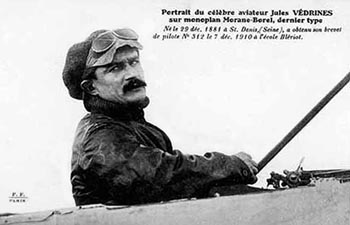 Jules Védrines http://perso.wanadoo.fr/d.fauvel
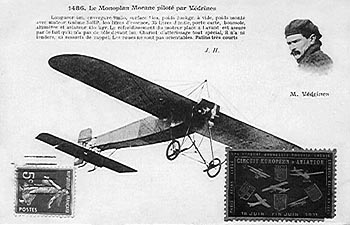 Jules Védrines download a 750pixel image
 Jules Védrines
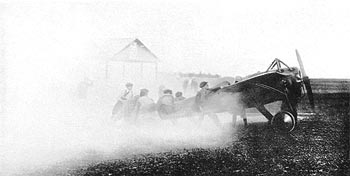 Jules Védrines, Chicago, 1912 download a 1000pixel or 1500pixel image
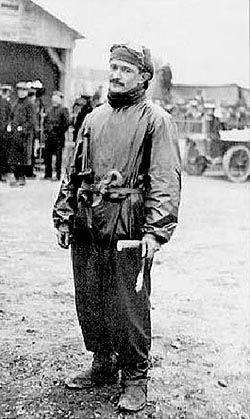 Jules Védrines, Chicago 1912
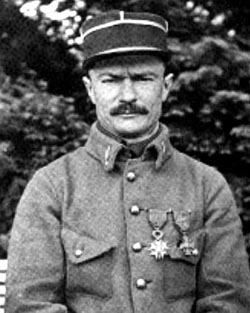 Jules Védrines, c.1914
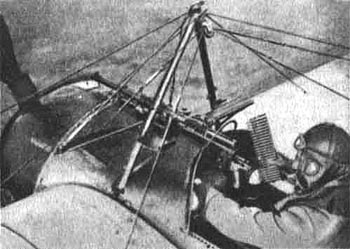 Jules Védrines
This first 'through the propeller' firing system was not invented as is often quoted, by Morane test pilot, Roland Garros. In fact fellow pilot Eugène Gilbert came up with the original idea (steel bands) which was by refined by Raymond Saulnier (steel plates), further developed by mechanic Jules Hue (refined steel plates) and then finally used in battle by Garros
|
© Copyright 1999-2002 CTIE - All Rights Reserved - Caution |
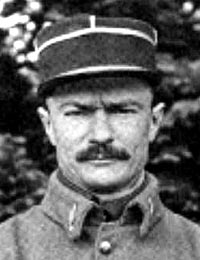 Jules Védrines
Jules Védrines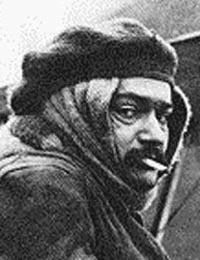 The first such event to be organised was the Paris - Madrid Air Race. It's beginning was not auspicious, however.
The first such event to be organised was the Paris - Madrid Air Race. It's beginning was not auspicious, however.